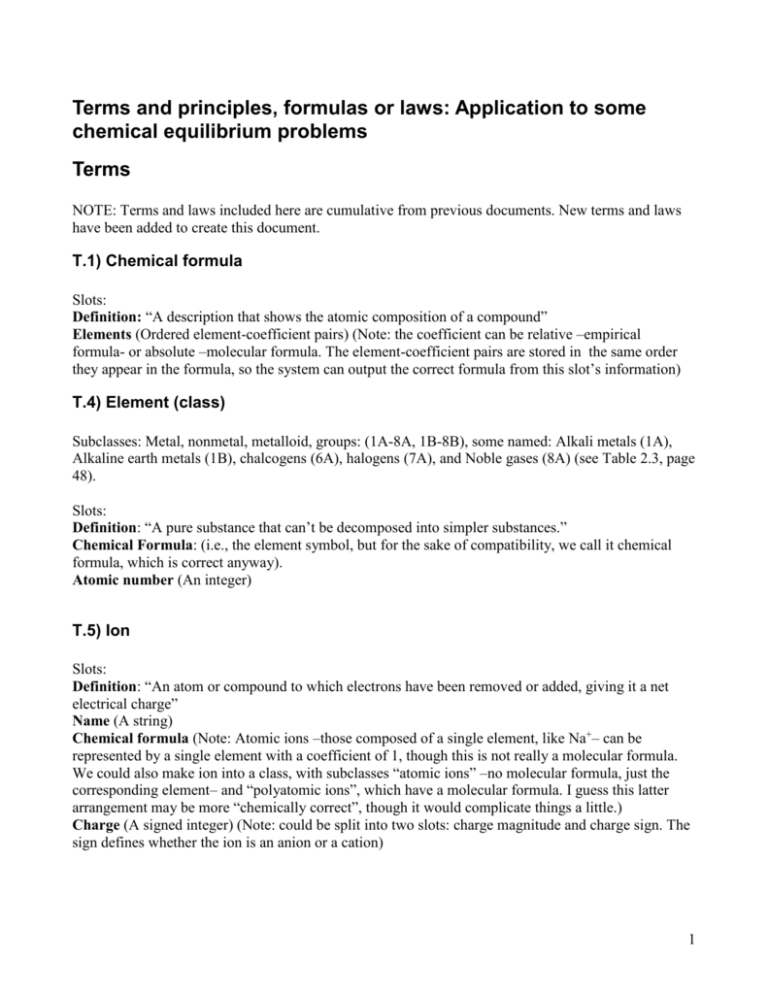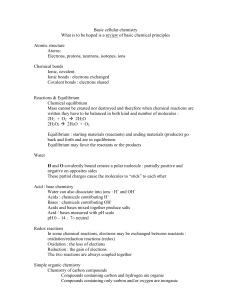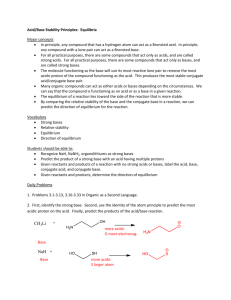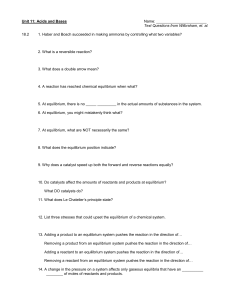to-do-note-from
advertisement

Terms and principles, formulas or laws: Application to some
chemical equilibrium problems
Terms
NOTE: Terms and laws included here are cumulative from previous documents. New terms and laws
have been added to create this document.
T.1) Chemical formula
Slots:
Definition: “A description that shows the atomic composition of a compound”
Elements (Ordered element-coefficient pairs) (Note: the coefficient can be relative –empirical
formula- or absolute –molecular formula. The element-coefficient pairs are stored in the same order
they appear in the formula, so the system can output the correct formula from this slot’s information)
T.4) Element (class)
Subclasses: Metal, nonmetal, metalloid, groups: (1A-8A, 1B-8B), some named: Alkali metals (1A),
Alkaline earth metals (1B), chalcogens (6A), halogens (7A), and Noble gases (8A) (see Table 2.3, page
48).
Slots:
Definition: “A pure substance that can’t be decomposed into simpler substances.”
Chemical Formula: (i.e., the element symbol, but for the sake of compatibility, we call it chemical
formula, which is correct anyway).
Atomic number (An integer)
T.5) Ion
Slots:
Definition: “An atom or compound to which electrons have been removed or added, giving it a net
electrical charge”
Name (A string)
Chemical formula (Note: Atomic ions –those composed of a single element, like Na+– can be
represented by a single element with a coefficient of 1, though this is not really a molecular formula.
We could also make ion into a class, with subclasses “atomic ions” –no molecular formula, just the
corresponding element– and “polyatomic ions”, which have a molecular formula. I guess this latter
arrangement may be more “chemically correct”, though it would complicate things a little.)
Charge (A signed integer) (Note: could be split into two slots: charge magnitude and charge sign. The
sign defines whether the ion is an anion or a cation)
1
T.6) Compound (class)
Subclasses: Molecular compounds, Ionic compounds.
Slots:
Definition: “A Pure substance that can be decomposed into simpler substances.”
Name (A string)
Chemical formula (A molecular or empirical formula, depending on the subclass)
T.7) Ionic compound
Superclass: Compound
Slots:
Definition: “A compound that contains both negatively and positively charged ions.”
Name (A string)
Chemical formula (Note: This information can be generated from the information in the “ions” slot.
Ion ordering is important for generating the empirical formula)
Ions (ion-coefficient pairs) can be ions or charged compounds. (Note: should be stored in the order
they appear in the formula –see the “elements” slot in T.1, chemical formula).
Charge: same as for ion.
T.8) Molecular compound
Superclass: Compound
Slots:
Definition: “A compound that does not contain ions.”
Name (A string)
Chemical formula
T.9) Solution (class)
Subclasses: Aqueous solution (Note: this is the only kind of solution we will study, so I am not sure
whether we need the “solution” class, or could simply use “aqueous solution”.)
Slots:
Definition: “An homogeneous mixture of substances”
Solvent (A compound)
Solutes Chemicals?
Volume (in liters)
2
Note: I am not sure whether the next two classes should exist or be combined into just one concept
(that of aqueous solution). The proposed subclass may facilitate solution of problems like N0. 26, but
you may be a better judge of that.
T.10) Aqueous solution (class)
Superclass: Solution.
Subclass: Electrolyte aqueous solution
Slots:
Definition: “A solution in which the solvent is water”
Solutes Chemicals?
Volume (in liters)
T.11) Electrolyte aqueous solution
Superclass: Aqueous solution
Slots:
Definition: “An aqueous solution in which all electrolytes or ionic compounds are totally or partially
dissociated”
Solutes Chemicals?
Volume (in liters)
T.12) Chemical
Slots
Definition: A chemical species (Compound, ion, element) that participate in a chemical reaction or a
solution.
Substance: A compound, ion or element.
Coefficient: Used for chemical reactions.
Quantity (or amount): in moles (used both for reactions and solutions)
Concentration: (molar) Used in solution and equilibrium problems.
T.13) Solubility of a substance
(This could be a slot for compound)
Definition (page 118, section 4.2): “The amount of a given substance that can be dissolved in a given
quantity of solvent”
NOTE: In the context of this project:
1. The solvent is always water (aqueous solution).
3
2. Solubility is not measured quantitatively, as implied by the definition above. We have two
categorical values: “soluble” or “insoluble”.
T.14) Precipitate
Definition (page 117, section 4.2): “An insoluble solid formed by a reaction in solution”
T.15) Chemical reaction (class)
Sublasses:
Slots
Definition (page 10, section 1.3): “A process in which substances are transformed into chemically
different substances”
Reactant(s): One or more chemicals
Product(s): One or more chemicals.
T.16) Acid-base equilibrium reaction
Subclass: Hydrolysis reaction
slots:
Definition (page 10, section 1.3): “A chemical reaction in which compounds exchange a proton (i.e.,
H+ ions)”
Reactant(s): two chemicals
Product(s): two chemicals.
Equilibrium constant: a real number
T.17) Hydrolysis reaction
slots:
Definition (page 10, section 1.3): “A chemical reaction in which a compounds exchange a proton with
water”
Reactant(s): One chemical and water
Product(s): One chemical and one of {[H+ or H3O-], OH-}.
Acid/base dissociation constant: a real number
Laws or Principles
L.1) Concentration of a solute
In a solution, the concentration of a solute i is given by the following formula:
4
Concentrationi = Quantityi / Volumesolution
L.2) Composition of strong electrolyte solutions
When an aqueous solution contains one or more strong electrolytes, each one of them dissociates into
their component ions. The quantity (in moles) of each ion in solution is given by the following
formula:
Quantityion = Quantityelectorlyte Coefficiention
That is, the ion’s quantity is equal to the quantity of the originating electrolyte multiplied by the ion’s
coefficient in the electrolyte’s chemical formula.
L.3) Conservation of mass
When mixing several solutions, the quantity of each solute in the resulting solution is equal to the sum
of the quantities of that solute in each of the original solutions.
L.4) Conservation of volume
When mixing several solutions, the volume of the resulting solution is equal to the sum of the volumes
of the original solutions.
L.5) Strong electrolytes
A compound is a strong electrolyte if either (1) it is an ionic compound, or (2) it is a strong acid or a
strong base (Tables 4.2 and 4.3 in the book)
L.6) Solubility of ionic compounds
Given an ionic compound, its solubility (soluble/insoluble) can be determined using the guidelines in
Table 4.1 in the book. (By definition, all ions are soluble.)
L.7) Precipitate formation
A precipitate forms when at least one of the products of a reaction is insoluble.
L.8) Chemical formulas of ionic compounds
When an anion is combined with a cation to form an ionic compound, the subscript of each ion is equal
to the charge magnitude of the other ion. Examples:
Mg2+ and N3- Mg3N2
Na+ and Cl- NaCl (subscripts = 1 are not written)
5
NOTE: We can also have a table with ionic compounds for different ion combinations.
L.9) Chemical reaction of two ionic compounds (exchange or metathesis
reactions)
The formulas for the product(s) of the reaction of two ionic reactants (ionic compound or ions) are
determined as follows: The cation of one reactant (if any) is combined with the anion of the other
reactant (if any) to form one product (Follow L.8 to generate the compound’s formula). Examples:
NaCl + KI NaI + KCl
Pb2+ + CaI2 Ca2+ + PbI2 (No anion in first reactant)
K+ + HCO3- KHCO3 (ion reactants, i.e., no anion in first reactant, no cation in second)
L.10) Chemical equilibrium
Reactions that do not reach completion reach a state in which the quantity of reactants and products are
in equilibrium (i.e., they are fixed in time). There are two reactions going on at the same time, one
from reactants to products (“forward” reaction) and one from products to reactants (“backward”
reaction). In equilibrium they both occur at the same rate. In aqueous solutions this means that the
concentrations of reactants and products are fixed.
L.11) Equilibrium-constant Expression (formula)
The equilibrium constant of an equilibrium reaction is given by the concentration of the chemical
species at equilibrium according to the following expression:
coefficient product
K eq
coefficient product2
]
2
coefficient reactant1
coefficient reactant2
[reactant 1 ]
[reactant 2 ]
[product 1 ]
1 [ product
where [X] means “concentration of substance X”, and coefficientX means the coefficient of substance
X in the reaction. As an example, for the generic equilibrium reaction:
A
+ B C + D
The equilibrium constant expression (formula) will be:
K eq
[C]χ [D]δ
[A]α [B]β
L.12) The position of equilibrium in a chemical reaction and the equilibrium
constant
6
In a chemical reaction, the side on which equilibrium lies (i.e., the side which has greater
concentration) is related to the equilibrium constant as follows:
If Keq > 1, the equilibrium (or the reaction) lies to the right (that is, toward the “products” side).
If Keq < 1, the equilibrium (or the reaction) lies to the left (that is, toward the “reactants” side).
L.13) Heterogeneous equilibria
Pure solids, pure liquids and solvents are not included in the equilibrium-constant expression (section
15.3).
L.14) Arrhenius definition of acids and bases
Acids are substances that, when dissolved in water, increase the concentration of H+ ions.
Bases are substances that, when dissolved in water, increase the concentration of OH- ions.
L.15) Brønsted-Lowry definition of acids and bases
An acid is a substance that can donate a proton to another substance.
A base is a substance that can accept a proton.
L.16) Acids and bases in acid-base reactions
In any side (right/products or left/reactants) of an acid-base reaction, the acid is the substance that loses
a proton (H+ ion), and the base the one that gains a proton. (This can be determined by checking the
chemical formulas of reactants and products: when a product differ from a reactant only in that is has
one more[less] hydrogen atom we say the reactant lost[gained] a proton, respectively, and the product
gained[lost] a proton, respectively).
L.17) Relative strengths of acids and bases
The relative strengths of different acids and bases (in the Brønsted-Lowry sense) are shown in Figure
16.4 (page 618).
L.18) Amphoteric substances
An amphoteric substance can both loose and gain a proton (so, it is of the form HX). An amphoteric
substance acts as a base when combined with something more acidic than itself, and as an acid when
combined with something more basic than itself.
L.19) Conjugate acids/bases
An acid and a base that differ only in the presence or absence of a proton are called a conjugate acidbase pair. The conjugate base of an acid is formed by removing a proton from the acid. The conjugate
acid of a base is formed by adding a proton to the base.
7
L.20) Conjugate acids/bases in acid-base reactions
In acid-base equilibrium reactions, both the forward and the backward reaction involve proton
transfers, so the acid on the left hand side (reactants) of the reaction is the conjugate acid of the base on
the right hand side (products), while the base on the left hand side of the reaction is the conjugate base
of the acid in the right hand side.
L.21) Strengths of acids and bases
The relative strengths of different acids and bases (in the Brønsted-Lowry sense) are shown in Figure
16.4 (page 618).
L.22) The position of equilibrium in an acid-base equilibrium reaction
In any acid-base reaction the position of equilibrium (see law L.12) favors transfer of the proton to the
stronger base (page 619). That is, equilibrium lies on the side with the weakest acid and base (see Law
L.17 for relative strengths of acids and bases).
Inverse (Law L.22b?): In an acid-base reaction, the weakest acid and base are those on the side of the
reaction where equilibrium lies, and thus the strongest acid and base lie on the opposite side of the
equilibrium.
L.23) Hydrolysis of a substance
A substance reaction with water is called a hydrolysis reaction, or “the hydrolysis of <substance>”. If
the substance is a stronger base than water, it will take a proton (H+ ion) from water. Thus, the
chemical equation will be of the form:
X + H2O ↔ HX + OHOtherwise, if the substance is a stronger acid than water, it will give a proton to water, with a chemical
reaction of the form:
HX + H2O ↔ X + H3O+
L.24) The hydronium ion
The hydronium ion (H3O+) is equivalent to a proton (H+), so
[H3O+] = [H+]
L.25) Equilibrium-constant expression for hydrolysis reactions
For the hydrolysis of a substance:
HX + H2O ↔ X + H3O+
(HX = acid)
8
X + H2O ↔ HX + OH-
(X = base)
The equilibrium-constant is called the “acid (or base) dissociation constant”, Ka and Kb, respectively,
and its expression is:
K eq K
[product 1 ][ product 2 ]
[hydrolized compound]
(in general)
For example:
Ka
[X ][OH ]
[HX]
(for acids)
Kb
[HX ][ H 3O ] [HX ][ H ]
[X]
[X]
(for bases)
where the concentration of water (the solvent) is omitted, according to law L.13, and the
concentrations of hydronium ions ([H3O+]) and protons ([H+]) are equivalent, as stated in law L.24.
Solving some chemical-equilibrium related problems (sample
questions 6, 7, and 10)
Sample question 6
“Which of the following is the correct equilibrium expression for the hydrolysis of CO32-?”
Inputs
Hydrolysis of CO32-.
Result expected
Correct equilibrium [constant] expression for the reaction described by “hydrolysis of CO32-.”
Algorithm
1. Determine the equilibrium expression for the reaction by applying laws L.25. Need the
chemical reaction for the hydrolysis of CO32-.
2. Determine the chemical reaction for the hydrolysis of CO32- by applying law L.23 Need to
know whether CO32- is a stronger acid or a stronger base than water.
3. Using law L.17, determine whether CO32- is a stronger acid or a stronger base than water.
*So, we know that CO32- is a stronger base than water (3)
*So, the chemical reaction for the hydrolysis of CO32- is
CO32- + H2O HCO3- + OH- (2)
*So, the equilibrium expression for the hydrolysis of CO32- is
Keq = [HCO3-][OH-] / [CO32-] (1).
9
This corresponds to choice (b).
More general algorithm:
1. Determine the equilibrium expression for the reaction by applying laws L.11 and L.13. Need
the chemical reaction for the hydrolysis of CO32-.
2. Determine the chemical reaction for the hydrolysis of CO32- by applying law L.23 Need to
know whether CO32- is a stronger acid or a stronger base than water.
3. Using law L.17, determine whether CO32- is a stronger acid or a stronger base than water.
*So, we know that CO32- is a stronger base than water (3)
*So, the chemical reaction for the hydrolysis of CO32- is
CO32- + H2O HCO3- + OH- (2)
*So, the equilibrium expression for the hydrolysis of CO32- (where [H2O] has been omitted by
applying law L.13) is
Keq = [HCO3-][OH-] / [CO32-] (1).
This corresponds to choice (b).
Sample question 7:
“The equilibrium constant for the reaction represented below is greater than 1.0. Which of the
following gives the correct relative strengths of the acids and bases in the reaction?”
H2PO4- + HBO32- HPO42- + H2BO3-”
Inputs
Reaction: H2PO4- + HBO32- HPO42- + H2BO3K > 1.0
Outputs
Strongest acid and base in the reaction.
Algorithm
1. Determine the strongest acid and base by applying law L.22b. Need to know (a) which
substances are the acids, and which are the bases, and (b) where the equilibrium lies.
2. Determine the acids and bases of the reaction using law L.16.
*So the acids are H2PO4- on the left (reactants) and H2BO3- on the right (products); and the bases
are HBO32- on the left (reactants) and HPO42- on the right (products) (2).
3. Determine the position of equilibrium using law L.12.
*So, K > 1.0 The equilibrium lies to the right (products) (3).
10
*So, The strongest acid and base are on the left (reactants), so H2PO4- is the strongest acid and the
strongest base is HBO32-. This corresponds to choice (a).
NOTES: The interesting thing about this question is that a problem like this one could be solved using
law L.17 (this one can’t be, because H2BO3- and HBO32- don’t appear if Fig. 16.4), but the key datum
is the fact that Keq is > 1. The constraint here is that it is expected that you solve the problem by using
this information, which is not needed if one uses law L.17.
Another thing to note is that I encoded the question as “which are the strongest acid and base in the
reaction?” instead of “Does this expression give the correct relative strengths of the acids and bases in
the reaction?”. I am not sure how to allow for such encoding short of creating a new law.
Sample question 10
“HSO4- + H2O H3O+ + SO42In the equilibrium represented above, the species that acts as bases includes which of the following?
I.
HSO4II.
H2O
III.
SO42(5 choices)
Input
An equilibrium reaction: HSO4- + H2O H3O+ + SO42-
Outputs
The bases in the reaction.
Algorithm
1. Determine the bases in the reaction using law L.16.
*So, the bases are H2O and SO42-.
This corresponds to choice (e), i.e., II and III.
11







